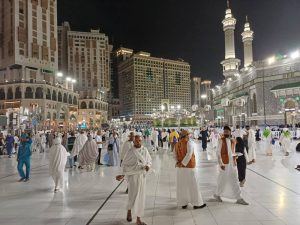
HAJJ the sacred pilgrimage to MAKKAH is far more than a physical journey. It is a profound act of worship, a cleansing of the soul, and a living reminder of submission, sacrifice, and unity. Every step, every ritual, and every moment of Hajj carries deep symbolism that connects the believer to the essence of ISLAM complete surrender to ALLAH.
The journey of Hajj is not just about traveling across deserts or performing rites; it is about transforming the heart. It reminds us that we are travelers in this world, moving toward our final return to ALLAH. Let’s explore the powerful meanings behind each step of this blessed journey.
IHRAM: A GARMENT OF EQUALITY AND PURITY
The moment a pilgrim enters the state of Ihram, they shed all worldly distinctions wealth, class, and status. The white, unstitched garments symbolize purity and equality before ALLAH. Kings and laborers, rich and poor, all stand side by side as servants of their Creator.
This simplicity reminds the believer of the kafan, the shroud in which one will one day be buried a powerful reminder that in death, all worldly differences vanish. Ihram is a declaration that the pilgrim has left behind material attachments and entered a sacred state of humility and devotion.
TAWAF: CIRCLING THE HEART AROUND ALLAH
As pilgrims circle the KA‘BAH seven times, they mirror the movement of the planets and the rhythm of the universe all orbiting in obedience to ALLAH’s will. Tawaf represents the believer’s life revolving around one center: Allah Alone.
Each round is a spiritual cleansing, a reaffirmation of faith, and a reminder that true peace lies in constant remembrance of ALLAH. The Ka‘bah becomes the heart’s focal point, symbolizing unity, devotion, and complete submission.
SA’I BETWEEN SAFA AND MARWA: FAITH IN DESPERATION
Running between the hills of SAFA and MARWA reenacts the story of HAJAR (AS), the wife of Prophet IBRAHIM (AS). Alone in the desert, desperate to find water for her infant son ISMA‘IL, she ran back and forth in unwavering faith.
Her struggle symbolizes trust in ALLAH even when logic fails. When she exhausted her efforts, ALLAH rewarded her sincerity with the well of ZAMZAM a timeless sign that divine help comes after sincere striving.
Every pilgrim who performs Sa’i is reminded of HAJAR’s courage, patience, and conviction. It teaches that faith is not passive it requires movement, effort, and trust that ALLAH never abandons those who rely on Him.
ARAFAT: THE MOUNTAIN OF MERCY
Standing on the plains of ARAFAT is the climax of Hajj the day when ALLAH descends His mercy upon His servants and forgives those who sincerely repent. The Prophet ﷺ said:
“Hajj is Arafah.” (Tirmidhi)
It is a powerful scene millions of people, dressed alike, raising their hands in supplication, crying, begging, and confessing before ALLAH. Arafat represents the Day of Judgment, when every soul will stand before its Creator.
It’s a reminder that nothing matters in that moment except the mercy of ALLAH. Titles, wealth, and worldly identity fade what remains is the heart’s sincerity.
MUZDALIFAH: GRATITUDE AND SIMPLICITY
After sunset, pilgrims travel to MUZDALIFAH, where they spend the night under the open sky. There are no walls, no roofs only the earth as a bed and the heavens as a blanket. It is a humbling experience that strips away comfort and reminds believers of their dependence on ALLAH.
Gathering pebbles for the next day’s ritual, pilgrims reflect on simplicity, patience, and gratitude. It’s a night of reflection one that teaches that peace is not found in luxury, but in contentment.
STONING THE JAMARAT: DEFEATING THE INNER SHAYTAN
At MINA, pilgrims throw stones at three pillars symbols of Shaytan reenacting Prophet IBRAHIM’s (AS) defiance when Shaytan tried to deter him from obeying ALLAH’s command.
This act is deeply symbolic. Each stone represents the believer’s rejection of temptation arrogance, greed, envy, anger, and disobedience. It is a physical reminder that the greatest Shaytan is not external but within the whispers of the nafs (ego) that seek to pull us away from righteousness.
THE SACRIFICE: COMPLETE SUBMISSION
The ritual of sacrificing an animal commemorates Prophet IBRAHIM’s (AS) willingness to sacrifice his beloved son ISMA‘IL in obedience to ALLAH’s command. Before the blade could fall, ALLAH replaced the boy with a ram symbolizing that sincere submission is what ALLAH truly desires.
This sacrifice teaches us to surrender our ego, desires, and attachments. It is a call to sacrifice not just animals, but our pride, arrogance, and sins everything that stands between us and ALLAH.
TAWAF AL-IFADAH AND FAREWELL TAWAF: RETURNING REBORN
The final Tawaf Tawaf al-Ifadah marks the purification and renewal of the pilgrim. By the end of Hajj, the believer emerges reborn forgiven, cleansed, and spiritually transformed.
Before leaving MAKKAH, pilgrims perform the Farewell Tawaf, circling the Ka‘bah one last time with tears of gratitude and longing. It symbolizes that while the body leaves MAKKAH, the heart should remain attached to it.
CONCLUSION
Hajj is a journey of the body, mind, and soul. Every step, every ritual, every moment is a lesson in faith, humility, and surrender. It reminds the believer that life itself is a pilgrimage filled with tests, trials, and moments of mercy.
Through Hajj, ALLAH teaches us that true worship lies not in ritual alone, but in transformation in purifying the heart, strengthening faith, and walking the path of submission long after we return home.
Hajj changes not only the destination of our bodies but the direction of our hearts forever turning them toward ALLAH.

